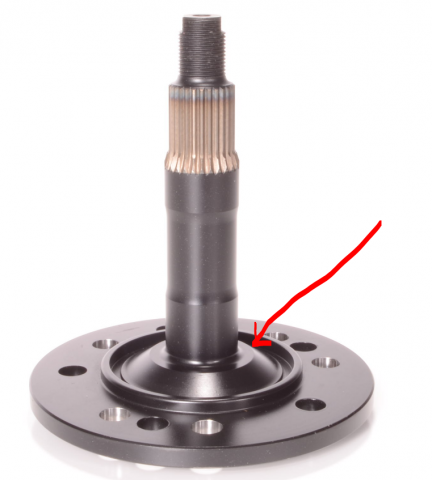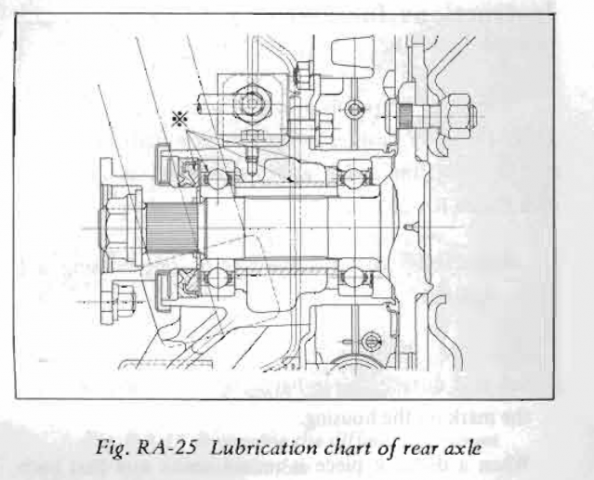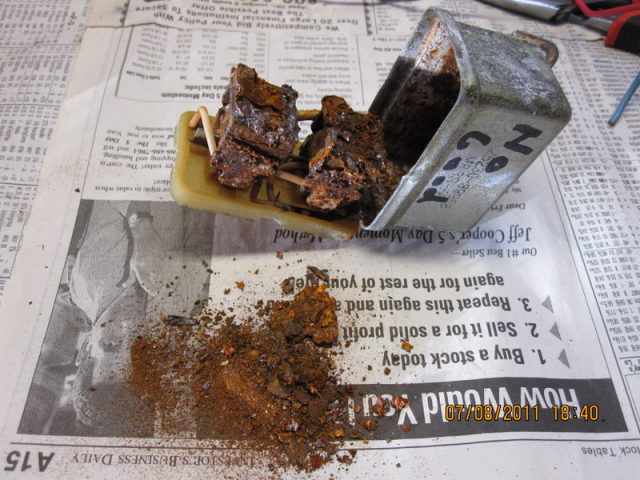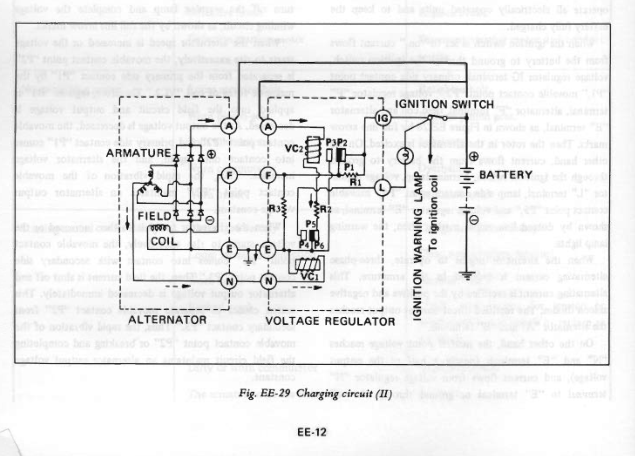
NewZed
Members-
Posts
6698 -
Joined
-
Last visited
-
Days Won
72
Content Type
Profiles
Forums
Blogs
Events
Gallery
Downloads
Store
Everything posted by NewZed
-
Don't overlook that when the engine is running and the alternator spinning that the bulk of the current is actually flowing through the alternator circuit. The battery is actually a low current draw. So it's the alternator charge wire and ground that might be most important. The battery is often thought of as the primary power source but when the car is in use, it's not really.
-
5 Speed Transmission goes into gears, but is always in neutral.
NewZed replied to supershanesta's topic in Drivetrain
Does "moved through all gears fine" mean that you turned the input shaft and saw the output shaft move, in each gear? Or did you just move the shift lever? If you did swap all of the parts, from flywheel to throwout bearing, and the bearing sleeve, the it seems like you've either jammed the pressure plate open somehow or the transmission is broken internally. I'd pull the rubber boot off of the clutch fork, look inside, and wiggle the fork to make sure that the throwout bearing sleeve is loose on the nose of the transmission. There should be play where the fork sits on the TOB sleeve. You might need a mirror or a camera to get a look since you're head probably won't fit close enough to see inside, and you'll probably want to disconnect the slave cylinder rod. If the pressure plate is applying pressure to the disc and the disc is splined to the input shaft then the input shaft has to turn. If it's turning then the output shaft has to turn when the trans is in gear. Are you sure that you din't leave the clutch disc out? That would make everything look normal but not work. -
Here's where the stink got big. I cleared up more about his problem in a few posts than he did in the whole thread. He's blowing up a simple problem in to a huge deal. He should have been able to tell them exactly what was wrong after the first fitting. Take a few measurements before putting it all back together and confirming 'binding". Take some responsibility for part of the problem. To screw up the basics of working with a machine shop, then call me "ignorant' is just too much. This is very basic Machine Shop 101 stuff. Child's play, if they had machine shop classes in grade school. I was just taking the other side to see what's what, but TZS showed what's happening with the "ignorant' comment. If I was DSS I'd give him his money back and say good riddance. Even if they get it right he'll probably screw something up and blame them for it.
-
I responded to what you communicated in your writing. The ignorance is yours. You said the dust cap, or ridge in this case, contacted the strut casting. Therefore, if it is removed it cannot contact it anymore. Because it's not there anymore. Pretty simple and basic. If that is not the case, then we're stuck with your poor communication. You seem like one of those nightmare customers. Poor communication, maybe due to a lack of understanding, then throwing insults when people question your lack of knowledge or ability. Good luck.
-
Well, it's more clear now. If you were telling them "hey, the dust shield is interfering with the casting and needs to be of smaller diameter and lower thickness" that's a lot different than just telling them "it's binding". The first gives them specific direction, the second is a riddle that they have to solve. My basic point is that clear communications will help them help you. Plus it helps people out here understand what the problem really is. You made it sound like they were completely incompetent, and made a part that wasn't even close to functional. A guy with a file could relieve that dust cap problem, if he really needed to. I could. How important is the race?
-
Thanks for clarifying. Although, that issue can be easily confirmed with a simple measurement before assembly, from the seat surface to the flange. If the outside flange is contacting then you could add shims to the inner race seat. If you wanted to save the bad axles. Good luck. Here's an image from Whitehead showing the seat surface that would need to be shimmed. https://whiteheadperformance.com/product/whp-billet-chromoly-stub-axles-27-spline-datsun-240z-260z-280z/
-
Of course, the guy at DSS should have realized this also and discussed it with you.
-
You didn't understand what I was saying. The axle does not "fit" the strut casting. It "fits" inside the inner race of the bearings. The bearings "fit" the casting. The distance piece determines the position of the inner races of the bearings, determining their lateral position on the axle. When you say the axle binds in the casting, it doesn't make sense, unless you mean that the axle won't spin after you torque the nut. Bind isn't really descriptive enough. Yesterday I thought you meant that it wouldn't even fit in the casting, but now I think that you mean it won't spin after assembly. If you mean that the axle won't turn when you reassemble everything, it's probably because the distance piece is too short, causing the inner races to be pulled in too far, binding the bearings in their races. Did you remember to install the distance piece? And make sure that it matches the casting, as described in the FSM? The inner race bearing seat on the wheel side of the axle is the only dimension that might affect binding and only if it is so far offset that it allows one of the flanges to contact the casting. Otherwise it's the distance piece and the bearings, and only after torquing the nut.
-
It seems that what you're saying is that DSS could not copy the dimensions of a stock axle correctly. Not really clear what the problem is on the fit though, since the axle just has to fit inside the bearings and have a proper seat on the flange side. Binding would most likely be between the bearing inner race and the shaft. Not a huge deal, you could have sent them bearings also, so they could check fit. Seems like there might be poor communication. On November 19 you had something that was about ready to go back together. Then Lee offered to make it better, apparently by making a brand new part, that they do not currently offer. Somehow, something came back wrong, but you haven't really described what. Is it possible that DSS is not 100% responsible for these problems? It's their first time making a full 240Z axle, if I read your posts right. Looks like they're in that classic old situation of getting hammered for being too helpful.
-
Curious what you mean by the axles are binding in the housing. Only the bearings should actually touch the housing. Maybe I missed where you determined exactly where the binding was. Might help DSS get it right.
-
cranks, but no start/ignition (video)
NewZed replied to SoFlaZ06's topic in S30 Series - 240z, 260z, 280z
That area is where the water drains down if it gets through the windshield, and the car is angled a certain way. The car has water marks under the passenger seat from the puddle that sat there for while. Only the Accessory relay didn't work though. The PO had a jumper wire ran up to the ignition switch for that. -
cranks, but no start/ignition (video)
NewZed replied to SoFlaZ06's topic in S30 Series - 240z, 260z, 280z
Could be worse. Here's the one that came out of my car, a 1976 model. The one in front of me now is actually my EFI relay, I was mixed up on my last post. Thanks for the tip on the wiring diagram. -
cranks, but no start/ignition (video)
NewZed replied to SoFlaZ06's topic in S30 Series - 240z, 260z, 280z
That is some nice detective work, and solution. Do you have the info on the replacement relay? They don't last forever, I have a dead one sitting in front of me right now. Luckily, my car came with a spare. -
There's made to order - https://www.mcmaster.com/#spacers/=1b3phas You could probably run without them if you spin the ring gear in its loaded direction. Reverse and engine braking won't matter much. In principle, the clamping force of the bolts is supposed to be enough.
-
Do you mean that the brakes don't slow the car? Or that the brakes are difficult to control? The rock-hard pedal is typical of a missing reaction disc in the booster. Measure vacuum at the end of the booster supply hose. Maybe you have the check valve installed backward. The MC cylinder size won't affect pedal feel as much as pedal travel.
-
cranks, but no start/ignition (video)
NewZed replied to SoFlaZ06's topic in S30 Series - 240z, 260z, 280z
Do the basics with a meter. Turn the key on and check for power at the coil and at the injectors. Check for coil power when you turn the key to Start. Check your fuses and fusible links and grounds. Could be a simple loose connection or something like a bad ignition relay. Once you know what's getting power when it should and what's not you'll have a clearer idea of what might be wrong. -
cranks, but no start/ignition (video)
NewZed replied to SoFlaZ06's topic in S30 Series - 240z, 260z, 280z
It did this? -
Make sure that you don't have some sort of current draw that is draining your battery. Are you jump-starting the car to get it going? It is very very very common for reman alternators to fail. Many people get bad reman alternators directly from the parts stores. The parts store should not give you too much trouble. Their supplier is used to get a high percentage of the product back under warranty. It's also very very common for the parts stores' test machines to show that they're not bad. You have to be forceful. They're used to it. Search "reman alternator failed" on Google and you'll find stories that cover every brand of car.
-
The 81 280ZX alternator is essentially the same alternator as the 1978, it's a direct bolt-in. They're both 60 amp, it's not an upgrade. You're right, there is no swap to worry about, no wires. The L wire is there to charge the windings, 11.8 volts is fine. The auto parts stores are well-known for giving misleading test results. Just convince the guys at the store that it has a bad bearing, because of the noise, and get one of the free life-time replacements. That's why they have the replacement policy, because so many of them go bad.
-
The 78 ignition system doesn't use the ballast resistor. It has a more powerful spark. The distributors themselves can be swapped easily by disconnecting the red and green wires. Leave the 78 ignition module in place, it's better. Use the distributor with the best breaker plate. Check the bearings and lube them up. The get rusty. If you want to dig deeper, take the breaker plate out and check the centrifugal weight numbers to see how much advance you'll be getting. Make sure the springs are good and the slots aren't worn out. You won't have to worry about the drive gear unless you remove the oil pump on the new engine. The 78 distributor will drop right in once you get the tang aligned with the slot. If the 76 engine was correct, you'll be fine on timing. It's a straight drop-in swap.
-
CS144 Alternator is not charging battery
NewZed replied to tamo3's topic in S30 Series - 240z, 260z, 280z
Not Tim, but...your video looks right, with the light coming on with the key (current passing from the battery through the charge/warning lamp to the alternator windings) and turning off when the engine starts (current generated by the alternator stopping flow from battery). But, you should rev the engine to 2000 - 2500 RPM too be sure that the regulator is limiting current. Z's are notorious for having low output at idle RPM, and it's possible that over-voltage could happen with more RPM. It should stick at 14.7, your idle voltage by your meter, as you rev the engine. Up to 15 or so would be okay also. 16's, not so good. Assuming that the regulator is regulating though, everything looks right. Nice result after a lot of work. -
280z Rear Disc Conversion, Sport Kit from ZCarDepot
NewZed replied to Boog's topic in Brakes, Wheels, Suspension and Chassis
I don't know that system exactly but I've worked brakes in general. It looks right to me. Just make sure that the passage from the bleed screw to the caliper piston cylinder hits the cylinder at at the top. You can see the casting marks from the outside. The calipers are designed for a certain orientation and the bleed screw is positioned for convenience. The screw might might be right, but the passage might enter low. Think about air bubbles.- 5 replies
-
- brake conversion
- rear disc
-
(and 2 more)
Tagged with:
-
CS144 Alternator is not charging battery
NewZed replied to tamo3's topic in S30 Series - 240z, 260z, 280z
People don't seem to be reading each other's posts. My images were from what is supposed to be a 1975 FSM. I've seen discussions about whether it actually is in the cars. It might be that Nissan used old images but never put the light in the early Z's. Even the 1972 FSM shows a Charge lamp, and it has an ammeter. I suggested that the Charge lamp might be burned out also. Maybe Charge lamp and Warning lamp are not the same. Who knows. In the 1972 image they call it a Warning lamp, see below, in 1975 they call it a Charge lamp, see my previous post. Your image is from the models with a "starter interlock", and they've cut out a portion of the diagram. The arrow starts from nowhere. The ones I inserted show the circuit back to the ignition switch. They all go to "L" on the voltage regulator though. "S" is typically connected directly to the battery positive, at the starter lug, where the positive cable attaches. If you attach L to S there will be a constant draw on the battery, through the windings. That will probably drain the battery. Whatever you decide to do, use your meter to confirm that you have power on the wire.



